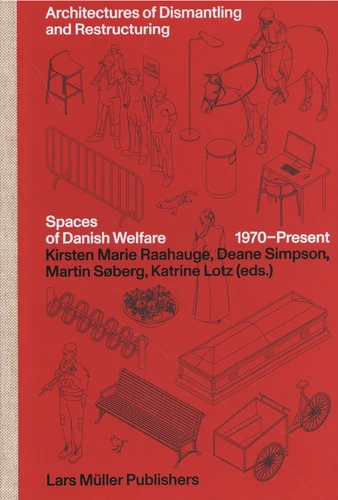Architectures of Dismantling and Restructuring. Spaces of Danish Welfare 1970-Present
Par : , , ,Formats :
- Paiement en ligne :
- Livraison à domicile ou en point Mondial Relay indisponible
- Retrait Click and Collect en magasin gratuit
- Nombre de pages464
- PrésentationRelié
- FormatGrand Format
- Poids1.2 kg
- Dimensions18,0 cm × 25,0 cm × 4,3 cm
- ISBN978-3-03778-691-8
- EAN9783037786918
- Date de parution01/05/2022
- ÉditeurLars Müller Publishers
Résumé
This publication explores a series of urgent questions addressing architecture's role in the welfare and everyday life of citizens, from the interdisciplinary perspectives of architecture, art history and anthropology. With Denmark as a case, it examines how the spatiality of the welfare system has transformed, since the end of the so-called "golden age of the welfare state" in the early 1970s until today.
How have these spatial changes impacted the everyday lives and welfare experiences of citizens ? What happens when institutions are restructured, dismantled or displaced ? How do emerging types of welfare space inform - or become informed by - changed role of the welfare system in our everyday lives ? Rather than unfolding a singular narrative of loss associated with welfare dismantlement - or one of humanization and restructuring of modernist planned environments - it describes complex and shifting spatial materializations of welfare and the "good life" under the influence of a Danish version of the neoliberal turn and other important societal transformations.
How have these spatial changes impacted the everyday lives and welfare experiences of citizens ? What happens when institutions are restructured, dismantled or displaced ? How do emerging types of welfare space inform - or become informed by - changed role of the welfare system in our everyday lives ? Rather than unfolding a singular narrative of loss associated with welfare dismantlement - or one of humanization and restructuring of modernist planned environments - it describes complex and shifting spatial materializations of welfare and the "good life" under the influence of a Danish version of the neoliberal turn and other important societal transformations.
This publication explores a series of urgent questions addressing architecture's role in the welfare and everyday life of citizens, from the interdisciplinary perspectives of architecture, art history and anthropology. With Denmark as a case, it examines how the spatiality of the welfare system has transformed, since the end of the so-called "golden age of the welfare state" in the early 1970s until today.
How have these spatial changes impacted the everyday lives and welfare experiences of citizens ? What happens when institutions are restructured, dismantled or displaced ? How do emerging types of welfare space inform - or become informed by - changed role of the welfare system in our everyday lives ? Rather than unfolding a singular narrative of loss associated with welfare dismantlement - or one of humanization and restructuring of modernist planned environments - it describes complex and shifting spatial materializations of welfare and the "good life" under the influence of a Danish version of the neoliberal turn and other important societal transformations.
How have these spatial changes impacted the everyday lives and welfare experiences of citizens ? What happens when institutions are restructured, dismantled or displaced ? How do emerging types of welfare space inform - or become informed by - changed role of the welfare system in our everyday lives ? Rather than unfolding a singular narrative of loss associated with welfare dismantlement - or one of humanization and restructuring of modernist planned environments - it describes complex and shifting spatial materializations of welfare and the "good life" under the influence of a Danish version of the neoliberal turn and other important societal transformations.


